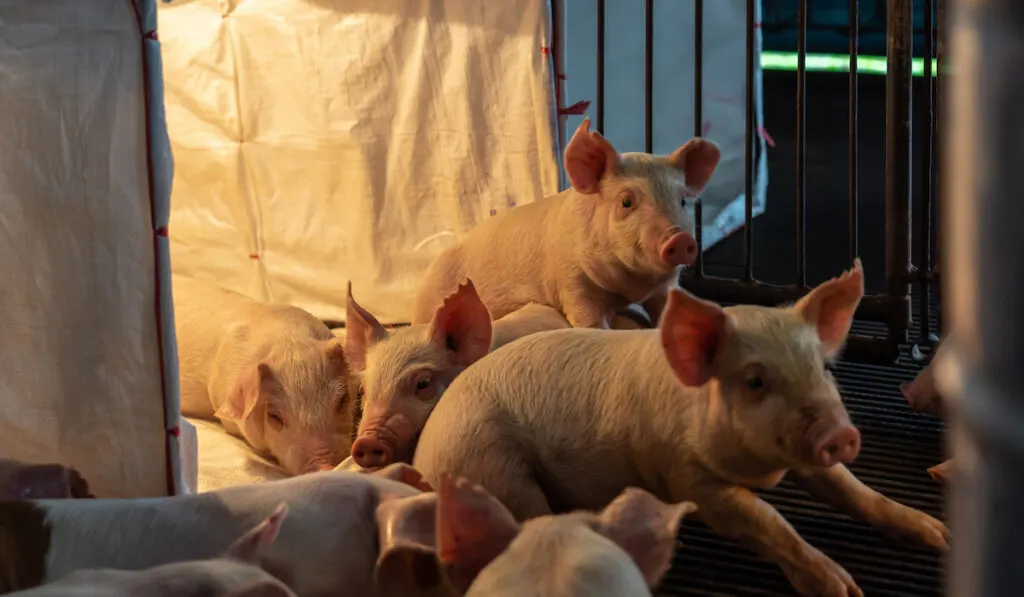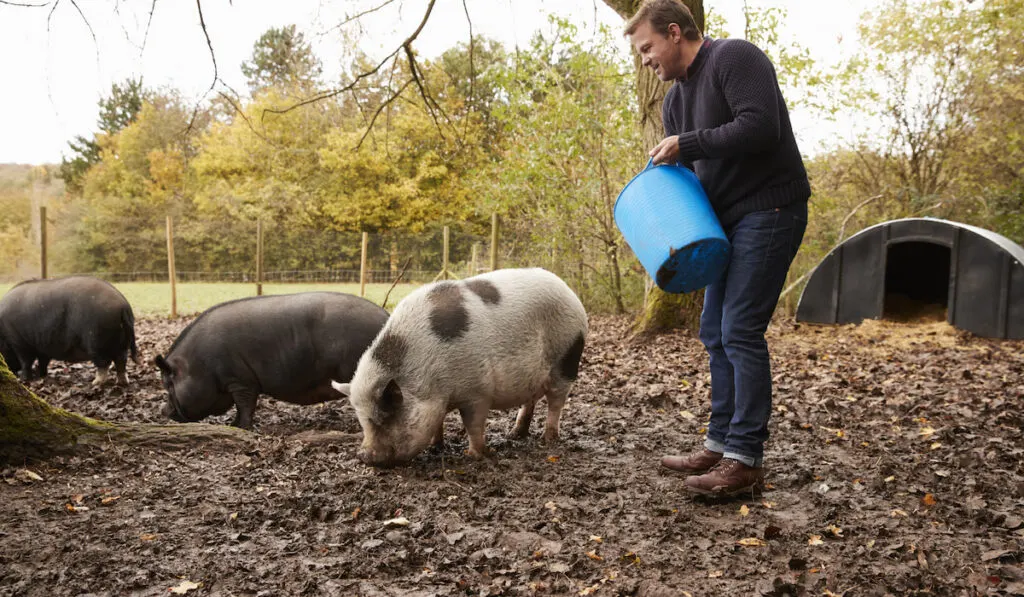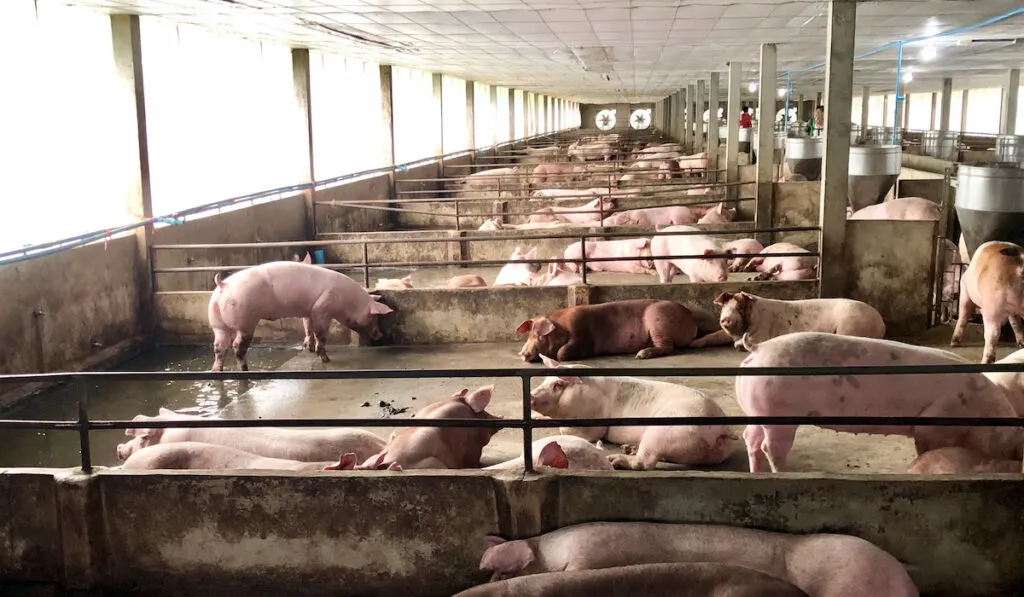Almost every homesteader I have met has launched into a passionate discussion on their desire to grow organic food, and they’re not just talking about vegetables!
But how much does it cost to buy, feed and slaughter a pig? And is it worth it?
It will cost a homesteader between $165 to $850 to buy, feed and process a pig from weanling to slaughter.
Variables such as the region, season, pig breed, and type of farm operation influence the cost of raising pigs. The price per pound of hanging meat ranges between $2.50 and $3.30.
The cost of raising a pig is variable. Yes, I know that answer will drive you crazy, but it’s the truth. This article can be viewed as the cliff notes on the cost of buying, feeding, and processing pigs from weanling to slaughter.

Table of Contents
How Much Do Pigs Cost at Weaning?
The main costs associated with buying, feeding, and raising pigs on a homestead include:
- Cost of weanling purchase: $50.00 to $200.00.
- Cost of feeding a pig from weaning to slaughter: $115 to $450.
- Cost of slaughtering and butchering a pig: $0 (farm processed) to $200 (professional abattoir and butcher).
- Average cost per pound of hanging meat: $2.50 to $3.30.
What Is the Cost of Buying a Pig?
Heritage pig breeds are slower-growing pigs with a higher fat ratio, better marbling, and more flavorful cuts. However, these pigs are less food efficient and cost more to raise than commercial pig breeds.
Commercial breeds, informally known as “pink pigs,” have been selectively bred to enhance profitability. In other words, these pigs are fast growers with an efficient food conversion ratio.
The meat produced from these commercial breeds is leaner, with less marbling than the meat derived from heritage pig breeds.
Most homesteaders prefer to stick with the hardy, low-maintenance heritage breeds. The heritage breeds provide an optimal balance between cost versus value when farming on a small scale.
Homesteaders dreaming about making a profit off their porcine endeavors would do better to stick with a commercial breed or a commercial-heritage mixed-breed pig.
The cheapest pigs to buy are commercial weanlings. A weanling pig is approximately 8 weeks and is eating solid feed. The average price to break even on a weanling pig is $46.43.
However, like the rest of us, farmers need to make a living, and so the average sale price for healthy weanlings ranges from $50.00 to $200.00.
What Variables Influence the Sale Price of Weanling Pigs?

The price of weanling pigs will vary based on numerous variables:
- The breed of pig – Heritage breeds are often more expensive than commercial breeds.
- The weight of the weanling at sale – The heavier the piglet at weaning, the higher the sale price.
- The season – Everyone wants to buy weanlings during spring, as summer raised pigs have a lower cost per pound of meat produced. The increased demand pushes the sale price of spring-sold weanlings up.
- Regional variances – Depending on the availability of pigs in your area, the cost will go up or down. The more pigs sold in the area, the lower the average price.
What Is the Cost of Feeding a Pig?
Without a doubt, the most significant cost associated with raising pigs is the cost of feed. Feed costs account for two-thirds of the cost per pound of meat produced.
Again, each homesteader will need to choose how to raise and feed their pigs. There are four common strategies used to feed pigs:
- Pasture vs. penned pigs
- Organic vs. non-organic feeding
Historically, pigs roamed the farm, grazing off the fields and being fed scraps from the home, butcher, and dairy. A similar practice underpins modern pasture grazing.
A pasture-raised pig will cost less to feed per day but may cost more to feed per pound of meat produced. A pasture-raised pig will move around more than a pig housed in small pens, i.e., these pigs burn more calories per day than penned pigs.

A pasture-raised pig should have access to a balanced corn and soy-based feed at all times.
Penned pigs raised in commercial settings are raised exclusively on a balanced grain meal. The pigs have access to the grain at all times and quickly gain weight.
According to the College of Agricultural Sciences at Pennsylvania University, each commercially raised pig will eat approximately 45 pounds of feed each week, which will amount to approximately $2.65 per week.
It is essential to note that the above figure is calculated for non-organic grains fed to penned commercial pig breeds.
Why Does the Cost of Pig Food Matter?
Pig farmers spend hours measuring, calculating, and evaluating the benefit versus cost of the pig food.
The cost and quality of feed directly impact the quality of meat produced and the profit margins.
A simple formula allows homesteaders to calculate the feed conversion rate (FCR):
FCR = Total Pounds of Food Fed (from weaning to slaughter) / time to raise
Most commercial farms aim to achieve a ratio of 2.5. However, most homesteaders can expect to achieve a higher FCR; up to 3.75 FCR is considered a win for a homesteader.
From the FCR ratio, you can calculate the cost of food per pound of hanging meat.

I Heard That Pigs Can Be Fed for Free; Is This True?
Many people claim that you can feed pigs for free or virtually free. Typically, these enterprising homesteaders negotiate a deal with a local produce store, in which they collect the old or spoiled food for free.
When evaluating the cost versus benefit ratio of free pig food, there are several factors to consider:
- Collecting spoiled feed from local bakeries, produce stores, dairies, and butcheries is time-consuming. Every homesteader knows that time is one of their most valuable (and scarce) commodities.
- It is essential to calculate whether the time expense is worth the benefit of free pig food.
- The second “hidden” cost to account for is fuel. The fuel price has risen to alarming heights, and most homesteaders are operating on a tight budget. When calculating the cost of “free food,” always include the fuel cost required to make those weekly or biweekly collections.
- Lastly, the quality of food fed impacts growth rates, meat quality, and feed conversion rates. Poor quality or incorrectly balanced foods will negatively impact the pigs and may cost more in the long run.

Don’t Forget the Other Costs of Pig Raising!
While purchase price and feed costs are the most significant costs associated with pig raising, other variables to consider include:
- Land: 2 pigs per acre of land if you intend to raise them in a pasture.
- Facilities: a small herd of 3 to 4 pigs raised in a pasture will need a simple shelter and pig-proof fencing.
- Environmental impact assessment: (this is only necessary for mid to large enterprises).
- Medical costs: Pigs are prone to internal parasites and require frequent deworming to prevent a costly worm burden. Male pigs intended for slaughter need to be neutered.
- Labor: If you pay someone else to do the physical work, the costs will need to be added.
- Slaughtering: $0 to $92
- Butchering: $100 to $150
Is the Cost of Pigs Worth It?
Most pigs are slaughtered at a live weight of 250lbs to 300lbs. Once slaughtered and dried, the carcass will weigh on average 30% less than the live weight. A 250lbs pig will produce a hanging carcass of 175lbs.
Hanging pig carcasses are typically sold for $3-$4 per pound of meat plus the cost of butchering, while most retailers sell premium bacon for upwards of $6.00 per pound.
While the profit margins per pound of meat may seem insignificant, the volume of pork produced amounts to significant savings.
A 170lbs hanging carcass produced for $2.50 per pound of meat amounts to a minimum saving of $255.
Conclusion
Most homesteaders can expect to raise a pig for a cost of $2.50 to $3.30 per pound of hanging meat.
When calculating the cost of raising a pig, it is essential to calculate the cost of all the variables. Regional and seasonal differences will significantly influence the cost of buying, feeding, and raising pigs.
